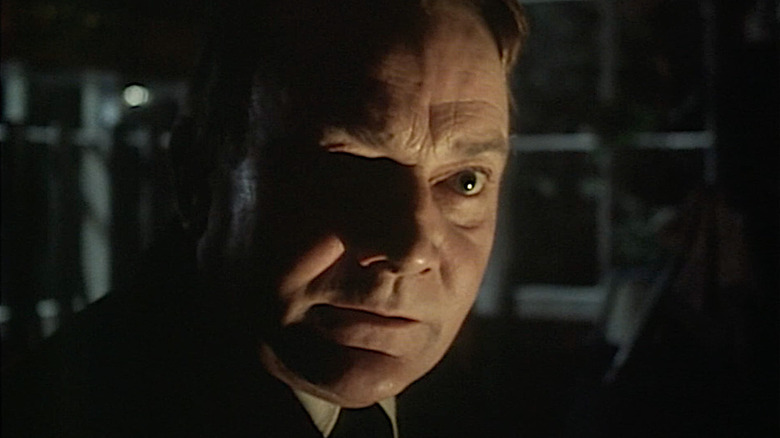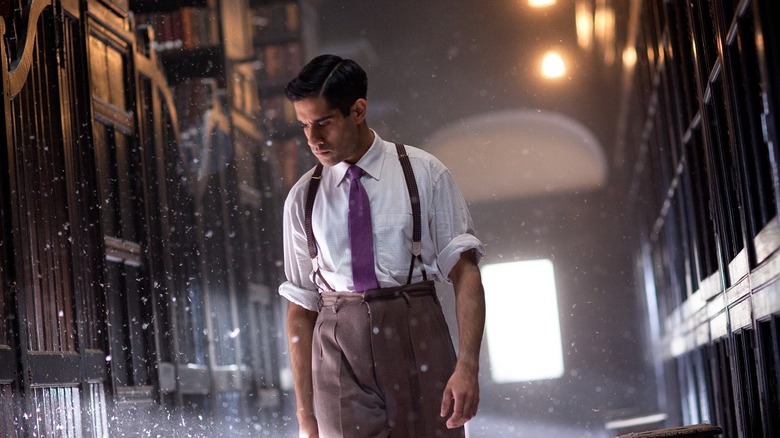The Spooky '70s TV Tradition That Still Lives On Today In The UK
We Brits have lots of festive traditions that visitors from overseas find unusual. As soon as Halloween is out of the way, the latest John Lewis advert becomes a national obsession. Thanks to "Bridget Jones's Diary," we love an ugly Christmas sweater. Over Christmas dinner, we pull crackers, stuff ourselves with turkey and pigs in blankets (sausages wrapped in bacon), then carry on gorging with mince pies while watching the King's speech on telly. Then there is one far spookier '70s TV tradition that still lives on today: "A Ghost Story for Christmas."
The practice of telling tales about ghosts and monsters while huddled around the winter fire goes back many centuries, but it really took off as a popular pastime in the Victorian era thanks to authors like Charles Dickens and M.R. James. In 1843, Dickens wrote "A Christmas Carol" to make ends meet, and it became not only the most famous festive story of all time, but also a great ghost story in its own right. 40 years later, James began reading his chilling yarns to entertain his college friends at Christmas gatherings.
James became known as the father of the modern ghost story, and his works loomed large when the BBC revived the tradition of eerie festive tales with "A Ghost Story for Christmas" in the 1970s. Following on from the broadcaster's acclaimed 1968 adaptation "Whistle and I'll Come to You" (one of the best Christmas horror movies), a new short TV film dropped every year between 1971 and 1978. After it was canceled, the series seemed like a quaint memory of Christmas past until the Beeb reinvigorated the format in 2005. Draw up a little closer, and we'll take a look.
A Ghost Story for Christmas in the '70s was all about atmosphere
All but one of the initial run of "A Ghost Story for Christmas" TV films were helmed by documentary filmmaker Lawrence Gordon Clark, and, working on 16mm with minimal budgets, his focus was mainly on atmosphere, suggestion, and creeping dread rather than in-your-face scares. Due to the thriftiness of the production, his movies have a stark, unsettling quality that gets under your skin and lingers long into the night.
The first five entries are all based on works by M.R. James and the best, "A Warning to the Curious," centers on a typically Jamesian scenario: A lone amateur archaeologist (Peter Vaughan) successfully unearths a lost Saxon crown only to find himself stalked by its ghostly guardian. The other episodes based on James's stories are also pretty strong: "The Stalls of Barchester" features Robert Hardy as an Archdeacon who may have caused the demise of his predecessor; "Lost Hearts" unnerves with the vengeful spirits of two murdered children; and "The Treasure of Abbot Thomas" revolves around more buried treasure and another ghastly sentinel. The weakest is arguably "The Ash Tree." It's my favorite James story, but the limited budget clearly wasn't enough to successfully visualize the nightmarish scenario.
Outside of the James canon, another strong contender for the best in the series originated from the pen of Charles Dickens. "The Signalman" is a slow-burning masterclass in understated fear starring Denholm Elliott as a solitary signalman troubled by a spectral harbinger. The last two entries, "Stigma" and "The Ice House," were both originals written for the screen and they're not very good, presumably resulting in the BBC's decision to pull the plug on the whole thing.
The new A Ghost Story for Christmas is glossy but not very scary
The BBC brought back "A Ghost Story for Christmas" in 2005, but it has been a rather mixed bag. The obvious problem is that the '70s run nabbed most of the best stories from M.R. James, and the glossier new-look films got off to an underwhelming start with "A View from a Hill" and "Number 13," two of his least consequential tales. Next up was a modern re-imaging of "Whistle and I'll Come to You," which featured a haunting performance from John Hurt but made some fatally distracting changes to the story.
The new TV films became a regular seasonal thing when Mark Gatiss got involved, and he has written and directed the last eight entries. Perhaps the best of his offerings so far is "The Tractate Middoth." Deeply rooted in James's love for antiquary and esoteric texts, this search for an elusive manuscript reveals the creepiest ghost since "The Signalman." Elsewhere, Simon Callow delivered a powerhouse performance in "The Dead Room," from an original story by Gatiss himself.
In more recent years, Gatiss has moved away from M.R. James to other authors. There was fun to be had with Sir Arthur Conan Doyle's "Lot No. 249" and the restless statues of "Woman of Stone" (from "Man-Size in Marble" by Edith Nesbit), but they're frankly a bit "Scooby Doo" compared to the originals. Gatiss is obviously a huge fan of ghost stories, but the higher production value has the unfortunate effect of diluting the horror. They're very watchable, but you need to head back to the '70s if you want pleasurable terror on a dark cold winter's night.


